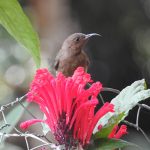DUSKY HONEYEATER
The Dusky Honeyeater is a fascinating bird native to Australia, with a presence that extends to nearby regions like New Guinea and the Lesser Sunda Islands. It is a small bird, typically measuring around 12 to 15 centimetres in length. Its plumage is predominantly a mix of brown and grey, with a subtle olive tint that gives it a dusky appearance, hence its name. The bird’s underparts are usually paler, and it has a slightly curved bill, perfectly adapted for feeding on nectar.
In Australia, the Dusky Honeyeater is commonly found in the northern regions, particularly in Queensland and the Northern Territory. It thrives in a variety of habitats, including mangroves, woodlands, and tropical rainforests. These birds are often seen flitting about in the foliage, searching for food.
Dusky Honeyeaters are known for their simple yet effective nesting techniques. They construct small cup-shaped nests using grass, bark, and spider webs, cleverly camouflaged among the leaves. The breeding season typically occurs from August to January, during which the female lays two to three eggs. Both parents share the responsibility of feeding the chicks once they hatch.
As their name suggests, honeyeaters primarily feed on nectar, which they extract from flowers using their specialised brush-tipped tongues. By feeding on nectar, Dusky Honeyeaters play a crucial role in pollinating various plant species, contributing to the health of their ecosystems. However, they are not strictly nectarivorous; they also consume insects and spiders, providing a balanced diet. This adaptability in feeding habits helps them thrive in various environments. These birds are highly adaptable, able to exploit a range of habitats and food sources, which aids their survival across diverse landscapes. They are often seen in pairs or small groups, especially when foraging, demonstrating their social nature.
While specific data on the lifespan of the Dusky Honeyeater in the wild is limited, honeyeaters generally have a lifespan that can range from a few years to over a decade, depending on environmental conditions and predation pressures.
The Dusky Honeyeater is a rather vocal bird, with a repertoire of calls that includes a series of melodious, high-pitched notes. Their calls can vary, often described as a musical twittering that adds a lively backdrop to their forested habitats.
Though not currently listed as threatened, the Dusky Honeyeater’s habitat is affected by deforestation and habitat fragmentation. Conservation efforts focused on preserving natural habitats are essential to ensure their continued survival.














